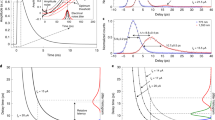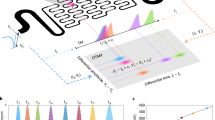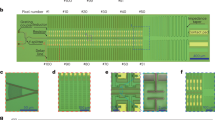Abstract
Detecting spatial and temporal information of individual photons is critical to applications in spectroscopy, communication, biological imaging, astronomical observation and quantum-information processing. Here we demonstrate a scalable single-photon imager using a single continuous superconducting nanowire that is not only a single-photon detector but also functions as an efficient microwave delay line. In this context, photon-detection pulses are guided in the nanowire and enable the readout of the position and time of photon-absorption events from the arrival times of the detection pulses at the nanowire's two ends. Experimentally, we slowed down the velocity of pulse propagation to ∼2% of the speed of light in free space. In a 19.7 mm long nanowire that meandered across an area of 286 × 193 μm2, we were able to resolve ∼590 effective pixels with a temporal resolution of 50 ps (full width at half maximum). The nanowire imager presents a scalable approach for high-resolution photon imaging in space and time.
This is a preview of subscription content, access via your institution
Access options
Access Nature and 54 other Nature Portfolio journals
Get Nature+, our best-value online-access subscription
$29.99 / 30 days
cancel any time
Subscribe to this journal
Receive 12 print issues and online access
$209.00 per year
only $17.42 per issue
Buy this article
- Purchase on Springer Link
- Instant access to full article PDF
Prices may be subject to local taxes which are calculated during checkout



Similar content being viewed by others

Change history
14 August 2017
In the version of this Article originally published, in Fig. 3c, in the y axis label, the units '(c.p.s.)' should not have been included; the label should have read "Dark counts". This has now been corrected in the online versions of the Article.
References
Zhang, L., Silberhorn, C. & Walmsley, I. A. Secure quantum key distribution using continuous variables of single photons. Phys. Rev. Lett. 100, 1–4 (2008).
Walborn, S. P., Lemelle, D. S., Almeida, M. P. & Ribeiro, P. H. S. Quantum key distribution with higher-order alphabets using spatially encoded qudits. Phys. Rev. Lett. 96, 1–4 (2006).
Mirhosseini, M. et al. High-dimensional quantum cryptography with twisted light. New J. Phys. 17, 033033 (2015).
Lamas-Linares, A. et al. Nanosecond-scale timing jitter for single photon detection in transition edge sensors. Appl. Phys. Lett. 102, 231117 (2013).
Gao, J. et al. A titanium-nitride near-infrared kinetic inductance photon-counting detector and its anomalous electrodynamics. Appl. Phys. Lett. 101, 142602 (2012).
Hadfield, R. H. Single-photon detectors for optical quantum information applications. Nat. Photon. 3, 696–705 (2009).
You, L. et al. Jitter analysis of a superconducting nanowire single photon detector. AIP Adv. 3, 72135 (2013).
Kerman, A. J., Rosenberg, D., Molnar, R. J. & Dauler, E. A. Readout of superconducting nanowire single-photon detectors at high count rates. J. Appl. Phys. 113, 144511 (2013).
Marsili, F. et al. Detecting single infrared photons with 93% system efficiency. Nat. Photon. 7, 210–214 (2013).
Yang, X. et al. Superconducting nanowire single photon detector with on-chip bandpass filter. Opt. Express 22, 16267–16272 (2014).
Marsili, F. et al. Efficient single photon detection from 500 nanometer to 5 micron wavelength. Nano Lett. 12, 4799–4804 (2012).
Rosenberg, D., Kerman, A. J., Molnar, R. J. & Dauler, E. A. High-speed and high-efficiency superconducting nanowire single photon detector array. Opt. Express 21, 1440–1447 (2013).
Zhao, Q. et al. Superconducting-nanowire single-photon-detector linear array. Appl. Phys. Lett. 103, 142602 (2013).
Miki, S., Yamashita, T., Wang, Z. & Terai, H. A 64-pixel NbTiN superconducting nanowire single-photon detector array for spatially resolved photon detection. Opt. Express 22, 7811–7820 (2014).
Allman, M. S. et al. A near-infrared 64-pixel superconducting nanowire single photon detector array with integrated multiplexed readout. Appl. Phys. Lett. 106, 192601 (2015).
Hofherr, M. et al. Time-tagged multiplexing of serially biased superconducting nanowire single-photon detectors. IEEE Trans. Appl. Supercond. 23, 2501205 (2013).
Hofherr, M. et al. Orthogonal sequencing multiplexer for superconducting nanowire single-photon detectors with RSFQ electronics readout circuit. Opt. Express 20, 28683–28697 (2012).
Doerner, S., Kuzmin, A., Wuensch, S., Ilin, K. & Siegel, M. Operation of superconducting nanowire single-photon detectors embedded in lumped-element resonant circuits. IEEE Trans. Appl. Supercond. 26, 2200205 (2016).
Gol'tsman, G. N. et al. Picosecond superconducting single-photon optical detector. Appl. Phys. Lett. 79, 705–707 (2001).
Yang, J. K. W. et al. Modeling the electrical and thermal response of superconducting nanowire single-photon detectors. IEEE Trans. Appl. Supercond. 17, 581–585 (2007).
Santavicca, D. F., Adams, J. K., Grant, L. E., McCaughan, A. N. & Berggren, K. K. Microwave dynamics of high aspect ratio superconducting nanowires studied using self-resonance. J. Appl. Phys. 119, 234302 (2016).
Calandri, N., Zhao, Q.-Y., Zhu, D., Dane, A. & Berggren, K. K. Superconducting nanowire detector jitter limited by detector geometry. Appl. Phys. Lett. 109, 152601 (2016).
Pond, J., Claassen, J. & Carter, W. Kinetic inductance microstrip delay lines. IEEE Trans. Magn. 23, 903–906 (1987).
Klopfenstein, R. W. A transmission line taper of improved design. Proc. IRE 44, 31–35 (1956).
Tsiatmas, A., Fedotov, V. A., García de Abajo, F. J. & Zheludev, N. I. Low-loss terahertz superconducting plasmonics. New J. Phys. 14, 115006 (2012).
Majedi, A. H. Theoretical investigations on THz and optical superconductive surface plasmon interface. IEEE Trans. Appl. Supercond. 19, 907–910 (2009).
Jagutzki, O. et al. A broad-application microchannel-plate detector system for advanced particle or photon detection tasks: large area imaging, precise multi-hit timing information and high detection rate. Nucl. Instrum. Methods Phys. Res. A 477, 244–249 (2002).
Duarte, M. F. et al. Single-pixel imaging via compressive sampling. IEEE Signal Process. Mag. 25, 83–91 (2008).
Gerrits, T. et al. Progress toward a high-resolution single-photon camera based on superconducting single photon detector arrays and compressive sensing. In Conf. Lasers and Electro-Optics (CLEO) STh30 (Optical Society of America, 2015).
Zhao, Q. et al. Counting rate enhancements in superconducting nanowire single-photon detectors with improved readout circuits. Opt. Lett. 39, 1869–1872 (2014).
Dorenbos, S. N. et al. Superconducting single photon detectors with minimized polarization dependence. Appl. Phys. Lett. 93, 161102 (2008).
Zheng, F. et al. Design of efficient superconducting nanowire single photon detectors with high polarization sensitivity for polarimetric imaging. J. Opt. Soc. Am. B 33, 2256–2264 (2016).
Gaudio, R., op ’t Hoog, K. P. M., Zhou, Z., Sahin, D. & Fiore, A. Inhomogeneous critical current in nanowire superconducting single-photon detectors. Appl. Phys. Lett. 105, 222602 (2014).
Annunziata, A. J. et al. Tunable superconducting nanoinductors. Nanotechnology 21, 445202 (2010).
Najafi, F. et al. Fabrication process yielding saturated nanowire single-photon detectors with 24-ps jitter. IEEE J. Sel. Top. Quantum Electron. 21, 1–7 (2015).
Yang, J. et al. Fabrication development for nanowire GHz-counting-rate single-photon detectors. IEEE Trans. Appl. Supercond. 15, 626–630 (2005).
Acknowledgements
We thank R. Hobbs, C.-S. Kim and M. Mondol for their technical support in nanofabrication, and P. Mauskopf, J.K.W. Yang, Z. Zhang and E. Toomey for scientific discussion. This research was supported by the National Science Foundation (NSF) grants under contract no. ECCS-1509486 (Massachusetts Institute of Technology (MIT)) and no. ECCS-1509253 (University of North Florida) and the Air Force Office of Scientific Research grant under contract no. FA9550-14-1-0052. D.Z. is supported by a National Science Scholarship from A*STAR, Singapore. N.C. thanks the Roberto Rocca project for financial support during his visit to MIT. A.E.D. was supported by a National Aeronautics and Space Administration Space Technology Research Fellowship (award no. NNX14AL48H). A.N.M. was supported by a fellowship from the National Science Foundation iQuISE program (award no. 0801525).
Author information
Authors and Affiliations
Contributions
Q.-Y.Z. and K.K.B. came up with the initial idea. Q.-Y.Z. designed and fabricated the nanowire imager. Q.-Y.Z. and D.Z. took the optical measurements. Q.-Y.Z., N.C., F.B. and H.-Z.W. characterized initial devices. A.E.D. developed the superconducting films. Q.-Y.Z., A.N.M. and D.F.S. did the microwave simulations. Q.-Y.Z. analysed the data and programmed the imaging script. K.K.B. supervised the project. Q.-Y.Z. and K.K.B. wrote the paper with input from all the other authors.
Corresponding author
Ethics declarations
Competing interests
The authors declare no competing financial interests.
Supplementary information
Supplementary information
Supplementary information (PDF 966 kb)
Supplementary information
Supplementary Movie 1 (MOV 19999 kb)
Rights and permissions
About this article
Cite this article
Zhao, QY., Zhu, D., Calandri, N. et al. Single-photon imager based on a superconducting nanowire delay line. Nature Photon 11, 247–251 (2017). https://doi.org/10.1038/nphoton.2017.35
Received:
Accepted:
Published:
Issue Date:
DOI: https://doi.org/10.1038/nphoton.2017.35
This article is cited by
-
Mid-infrared single-photon 3D imaging
Light: Science & Applications (2023)
-
Scaling up single-photon detector arrays
Nature Photonics (2023)
-
Single-photon detection using high-temperature superconductors
Nature Nanotechnology (2023)
-
A superconducting nanowire single-photon camera with 400,000 pixels
Nature (2023)
-
Readout-efficient superconducting nanowire single-photon imager with orthogonal time–amplitude multiplexing by hotspot quantization
Nature Photonics (2023)


